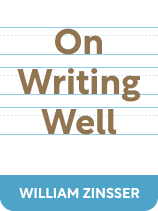

This article is an excerpt from the Shortform book guide to "On Writing Well" by William Zinsser. Shortform has the world's best summaries and analyses of books you should be reading.
Like this article? Sign up for a free trial here .
Do you want to discover your unique writing style? What sets your writing apart from everybody else’s?
You may be tempted to tailor your writing style to match what you often read online or in books, but that won’t gain you any popularity. Every good writer has their own personality and style, and it’s those differences that set them above the rest, not conformity.
Here is how to develop a writing style that’s uniquely yours.
What Is Identity in Writing?
In his book On Writing Well, William Zinsser’s third principle of good writing is identity, or what makes your writing unique to you. It’s the unique writing style and personality that you as an individual bring to your writing. Zinsser explains that identity is a writer’s most recognizable quality to a reader. If a reader likes your identity and the way you tell stories, they’ll read more of your writing because they’re interested in what you have to say and how you say it. Zinsser argues that identity will determine whether or not readers like you as a writer.
Identity also differentiates your writing from other writers. Due to unique writing styles, two writers can tell the same story in two completely different ways. While one way isn’t superior to the other, a reader will have a preference for one style over the other. Having a recognizable writing identity influences whether or not a reader chooses to read your work when they could read someone else’s.
| Elements of Identity Zinsser explains identity as putting your personality on paper, but this may be easier said than done. While identity can be hard to define, experts do outline a few factors that contribute to a writer’s individual style. Punctuation: Some writers make certain stylistic choices with their punctuation. For example, Sally Rooney is known for her omission of quotation marks. Sensory details: This is imagery that uses the senses: sight, smell, taste, touch, hearing, as well as kinesthetic sensations. Some writers prefer certain sensory details over others. For example, Chuck Palahniuk frequently describes smells in his writing. Figurative language, such as metaphors and similes: This is another stylistic device to add detail and connect ideas. The way you connect ideas is unique to you and thus your writing identity. Sound devices, such as alliteration and onomatopoeia: Just like the cadence of your speaking voice, the sound of your sentences can sound like you too. |
Zinsser believes identity is your personality and style revealing itself through words. While writing like yourself should eventually feel effortless, Zinsser offers these tips for finding your writing identity:
Write for Yourself
To write in your unique style, start by writing for yourself. Zinsser explains that your identity will shine through when you write about things that you want to write about. Or ask yourself what you want to read, and write about that. By letting your interests direct your writing topic, you’ll be more passionate when writing about it.
(Shortform note: In On Writing, Stephen King offers a different perspective, suggesting that you keep one reader in mind as you write: your Ideal Reader. Your Ideal Reader is usually the one person whose opinion you trust above all. You come to know your Ideal Reader’s tastes so well you can predict how he or she will feel about any particular thing you’re writing. The Ideal Reader helps give you an audience as you write rather than writing strictly for yourself, as Zinsser recommends. The Ideal Reader should also be an honest reviewer—supportive but unrelenting. You might disagree with Ideal Reader’s feedback, but you know there’s truth to it.)
Write in First Person
Once you find a topic you’re passionate about, write about it from your own perspective, or in first person. Zinsser explains that since we generally speak in first person, writing with “I” should feel natural. Avoid trying to tell a story through someone else’s eyes because it will place a barrier between your thoughts and your natural writing voice.
(Shortform note: If you’re still struggling to connect to your writing or topic, try practicing your skills of observation and reflection through “wakewalking” (as opposed to sleepwalking), which is a kind of meditation for writers. To wakewalk, take a walk outside and name things you see, such as a tree, rock, or stream. Then describe one of these things using all five of your senses. As you interact with the object, write down your internal feelings about it. It might stir up an old emotion or memory, or you might find a new way to describe it. By wakewalking, you can practice relating to the world and writing about the connections you make.)
Write Like Yourself All the Time
Zinsser advises against changing your voice from piece to piece. Writing in your own voice will help you develop your identity since you’ll be consistently practicing writing in your unique voice. Eventually, your voice will come to you immediately and naturally when you write. Readers will also recognize you by your unique writing style.
(Shortform note: Many bloggers’ success stems from developing a signature writing voice that readers instantly recognize. For example, readers recognize Mark Manson for his unashamed use of curse words, his storytelling, and his way of writing to the reader like a friend. Manson’s blog quickly gained a large following, so when he published The Subtle Art of Not Giving a F*ck, he already had a dedicated audience who was interested in his writing style and what he had to say.)
Write Like Your Favorite Writers
Zinsser recommends reading writers with great taste to study what those creative decisions look like. Then write as they write. They’re your favorite writers for good reason, so take the time to mirror their techniques and find what works for you. Don’t be afraid of copying them—Zinsser believes you’ll eventually graduate into your own unique voice.
(Shortform note: In Steal Like an Artist, Austin Kleon echoes Zinsser’s advice to take inspiration from great art and artists in any medium—doing so will help you create better art. Kleon recommends studying one artist, her work, and what you like about her work. Kleon believes that by copying your mentor’s work and creative process, you’ll create something new. The ways in which you’re different from your creative mentor will reveal your unique strengths and develop your taste. You’ll inevitably fail to create a perfect copy of your mentor’s work since it’s personal to her and her tastes—just as your work will be personal to you.)

———End of Preview———
Like what you just read? Read the rest of the world's best book summary and analysis of William Zinsser's "On Writing Well" at Shortform .
Here's what you'll find in our full On Writing Well summary :
- A back-to-basics approach to the craft of writing
- How to practice simple, clear, and engaging writing—even if you're not a writer
- How to effectively put your ideas into words






